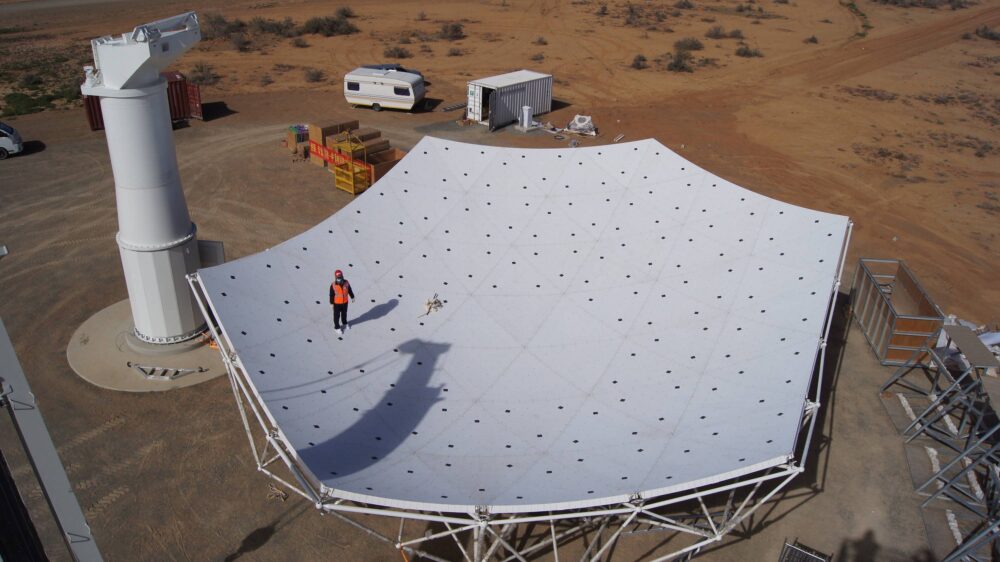Some of the satellite dishes that make up the MeerKAT. (Supplied)
International astrophysicists have commended South Africa’s development of radio telescopes for astronomy research, but have called for more collaboration from the country’s institutes to advance research in the field.
Three major radio telescopes are being developed in South Africa. The first, KAT-7, was completed in 2010 and served as a small seven-dish prototype to test technology and train local engineers for larger projects.
It was succeeded by the MeerKAT telescope, a powerful 64-dish array inaugurated in 2018, which has become the most sensitive radio telescope in the Southern Hemisphere.
It has already produced groundbreaking discoveries about black holes and distant galaxies. South Africa is expanding MeerKAT into the Square Kilometre Array (SKA-Mid), part of an international effort to build the world’s largest radio telescope.
Construction of the SKA began in 2021 with nearly 200 dishes planned and the first scientific observations expected around 2027.
“South Africa, basically for political reasons, came in and made a big investment in radio astronomy, because a key figure in the anti-apartheid movement was actually a radio astronomer and became quite influential in the government and encouraged funding in radio astronomy,” British astrophysicist Simon White told the Mail & Guardian recently on the sidelines of the Hong Kong Laureate Forum.
“The result of that has been the creation of radio telescopes, which are part of the global initiative called the SKA. The MeerKAT is what they call the pathfinder — it’s kind of a prototype object to test the technology from the SKA, and it’s working very well. This, I think, is a great success for South Africa.”
The forum brought together 12 Shaw Laureates — winners of the Shaw Prize, an international award recognising significant contributions in the fields of Astronomy, Life Science and Medicine as well as Mathematical Sciences — and young scientists to map out the present and future developments in these fields.
Scientists presented their latest discoveries on supermassive black holes in the Milky Way as well as their recent developments in robotics to help detect and diagnose health conditions.
 Progress In the Karoo Continues with the assembly of the Main Reflector SKA-MPI dish. Here we see the 66 panels in place on the backup structure. The main reflector measures 15 meter in diameter. (SARAO)
Progress In the Karoo Continues with the assembly of the Main Reflector SKA-MPI dish. Here we see the 66 panels in place on the backup structure. The main reflector measures 15 meter in diameter. (SARAO)
The Southern African Large Telescope (SALT) was an attempt to build a big telescope, but it reduced capabilities and was less successful on an international scale, White said.
“The MeerKAT is definitely working very well, so I think in this case, South Africa is playing to its strengths, if the government keeps supporting it,” he added.
“The SKA as a whole is a global collaboration, and it’s had some problems because some of the plans turned out to be more expensive and slower than intended, so it looks as though, at the moment, that the full plan won’t be achieved, so we have to scope back,” he said.
“I think South Africa already has a very good working telescope and it will probably get bigger, maybe not as much as anticipated, but you definitely have something there, in the same way as China has a really good facility which is being built, and now they are considering expanding it and building more and supporting telescopes and making the facility larger and even more effective, so building on your strengths is always a good way to go forward.”
Other scientists have said that research into the universe requires more collaboration with institutes from across the world.
The South African Astronomical Observatory has collaborated with the Chinese University of Hong Kong’s astronomical research department, which has advanced studies of gravitational waves from merging black holes and neutron stars, as well as other highly energetic phenomena.
“The South African Astronomical Observatory was helping us to build fibre bundles [mathematical structures used in physics and astrophysics]. We were discussing how to build fibre bundles for a long time,” Yan Renbin, a professor and Global Stem Scholar at the department of physics at the Chinese University of Hong Kong, told the M&G during a visit to the department.
“We were also recently thinking of putting the instrument in the South African Astronomical Observatory, but I think our main collaborator is moving institutions, so we are uncertain over how that collaboration will proceed in the future.”
 Max Planck Society funded SKA prototype dish in the Karoo. (Euro.Soft SRL)
Max Planck Society funded SKA prototype dish in the Karoo. (Euro.Soft SRL)
Reinhard Genzel, a German astronomer who was awarded the 2020 Nobel Prize for Physics for his discovery of a supermassive black hole at the centre of the Milky Way Galaxy, also said more collaboration is needed to study the expanding universe.
“We do this because it’s fun. We get the world together, and I would say, if South Africa makes contact with the German Science Foundation or Max Planck Institute for Extraterrestrial Physics, they would be delighted to see what you can do,” Genzel told the M&G on the sidelines of the forum.
“In order to get young people to come to Germany or support Germans coming to your country. I would love to have South Africans,” he said.
The journalist’s trip to Hong Kong to cover the Hong Kong Laureate Forum was sponsored by the Lee Shau Kee Foundation.